Doctors' Trial
The Doctors' Trial (officially United States of America v. Karl Brandt, et al.) was the first of 12 trials for war crimes of high-ranking German officials and industrialists that the United States authorities held in their occupation zone in Nuremberg, Germany, after the end of World War II. These trials were held before US military courts, not before the International Military Tribunal, but took place in the same rooms at the Palace of Justice. The trials are collectively known as the "subsequent Nuremberg trials", formally the "Trials of War Criminals before the Nuremberg Military Tribunals" (NMT).[1]
| Doctors' Trial | |
|---|---|
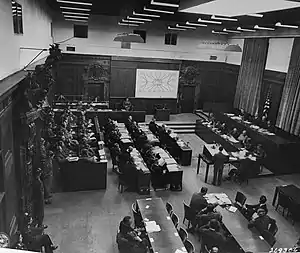 Courtroom at the trial, 12 December 1946 | |
| Court | Palace of Justice, Nuremberg |
| Full case name | United States of America v. Karl Brandt et al. |
| Started | 9 December 1946 |
| Decided | 20 August 1947 |
| Court membership | |
| Judges sitting |
|
Twenty of the twenty-three defendants were medical doctors and were accused of having been involved in Nazi human experimentation and mass murder under the guise of euthanasia. The indictment was filed on 25 October 1946; the trial lasted from 9 December that year until 20 August 1947. Of the 23 defendants, seven were acquitted and seven received death sentences; the remainder received prison sentences ranging from 10 years to life imprisonment.
Background
Twenty of the twenty-three defendants were medical doctors (Viktor Brack, Rudolf Brandt, and Wolfram Sievers were Nazi officials), and were accused of having been involved in Nazi human experimentation and mass murder under the guise of euthanasia. Philip Bouhler Ernst-Robert Grawitz Leonardo Conti and Enno Lolling commited suicide, while Josef Mengele, one of the leading Nazi doctors, had evaded capture.
The judges, heard before Military Tribunal I, were Walter B. Beals (presiding judge) from Washington, Harold L. Sebring from Florida, and Johnson T. Crawford from Oklahoma, with Victor C. Swearingen, a former special assistant to the Attorney General of the United States, as an alternate judge. The Chief of Counsel for the Prosecution was Telford Taylor and the chief prosecutor was James M. McHaney. In his opening statement, Taylor summarized the crimes of the defendants.[2]
"The defendants in this case are charged with murders, tortures, and other atrocities committed in the name of medical science. The victims of these crimes are numbered in the hundreds of thousands. A handful only are still alive; a few of the survivors will appear in this courtroom. But most of these miserable victims were slaughtered outright or died in the course of the tortures to which they were subjected. For the most part they are nameless dead. To their murderers, these wretched people were not individuals at all. They came in wholesale lots and were treated worse than animals."
Indictment
The accused faced four charges, including:
- Conspiracy to commit war crimes and crimes against humanity as described in counts 2 and 3;
- War crimes: performing medical experiments, without the subjects' consent, on prisoners of war and civilians of occupied countries, in the course of which experiments the defendants committed murders, brutalities, cruelties, tortures, atrocities, and other inhuman acts. Also planning and performing the mass murder of prisoners of war and civilians of occupied countries, stigmatized as aged, insane, incurably ill, deformed, and so on, by gas, lethal injections, and diverse other means in nursing homes, hospitals, and asylums during the Euthanasia Program and participating in the mass murder of concentration camp inmates.
- Crimes against humanity: committing crimes described under count 2 also on German nationals.
- Membership in a criminal organization, the SS.[3]
The tribunal largely dropped count 1, stating that the charge was beyond its jurisdiction.
I — Indicted G — Indicted and found guilty
| Name | Photograph | Function | Charges | Sentence | |||
|---|---|---|---|---|---|---|---|
| 1 | 2 | 3 | 4 | ||||
| Karl Brandt |  |
Personal physician to Adolf Hitler; Gruppenführer in the SS and Generalleutnant (Lieutenant General) in the Waffen SS; Reich Commissioner for Health and Sanitation (Reichskommissar für Sanitäts und Gesundheitswesen); and member of the Reich Research Council (Reichsforschungsrat) | I | G | G | G | Death by hanging, executed 2 June 1948 |
| Siegfried Handloser |  |
Generaloberstabsarzt (Lieutenant General, Medical Service); Medical Inspector of the Army (Heeressanitätsinspekteur); and Chief of the Medical Services of the Armed Forces (Chef des Wehrmachtsanitätswesens) | I | G | G | Life imprisonment; commuted to 20 years; released/died 1954 | |
| Paul Rostock | .jpg.webp) |
Chief Surgeon of the Surgical Clinic in Berlin; Surgical Adviser to the Army; and Chief of the Office for Medical Science and Research (Amtschef der Dienststelle Medizinische Wissenschaft und Forschung) under the defendant Karl Brandt, Reich Commissioner for Health and Sanitation | I | I | I | Acquitted; died 1956 | |
| Oskar Schröder |  |
Generaloberstabsarzt (Colonel General Medical Service); Chief of Staff of the Inspectorate of the Medical Service of the Luftwaffe (Chef des Stabes, Inspekteur des Luftwaffe-Sanitätswesens); and Chief of the Medical Service of the Luftwaffe (Chef des Sanitätswesens der Luftwaffe) | I | G | G | Life imprisonment; commuted to 15 years; released 1954; died 1959 | |
| Karl Genzken |  |
Gruppenführer in the SS and Generalleutnant (Lieutenant General) in the Waffen SS; and Chief of the Medical Department of the Waffen SS (Chef des Sanitätsamts der Waffen SS) | I | G | G | G | Life imprisonment; commuted to 20 years; released April 1954; died 1957 |
| Karl Gebhardt |  |
Gruppenführer in the SS and Generalleutnant (Lieutenant General) in the Waffen SS; personal physician to Reichsfuehrer-SS Himmler; Chief Surgeon of the Staff of the Reich Physician SS and Police (Oberster Kliniker, Reichsarzt SS und Polizei); and President of the German Red Cross | I | G | G | G | Death by hanging, executed 2 June 1948 |
| Kurt Blome | 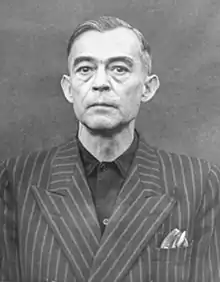 |
Deputy [of the] Reich Health Leader (Reichsgesundheitsführer); and Plenipotentiary for Cancer Research in the Reich Research Council | I | I | I | Acquitted; died 1969 | |
| Rudolf Brandt | .jpg.webp) |
Standartenführer (Colonel); in the Allgemeine SS; Personal Administrative Officer to Reichsführer-SS Himmler (Persönlicher Referent von Himmler); and Ministerial Counselor and Chief of the Ministerial Office in the Reich Ministry of the Interior | I | G | G | G | Death by hanging, executed 2 June 1948 |
| Joachim Mrugowsky | 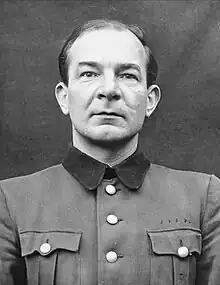 |
Oberführer (Senior Colonel) in the Waffen SS; Chief Hygienist of the Reich Physician SS and Police (Oberster Hygieniker, Reichsarzt SS und Polizei); and Chief of the Hygienic Institute of the Waffen SS (Chef des Hygienischen Institutes der Waffen SS) | I | G | G | G | Death by hanging, executed 2 June 1948 |
| Helmut Poppendick |  |
Oberführer (Senior Colonel) in the SS; and Chief of the Personal Staff of the Reich Physician SS and Police (Chef des Persönlichen Stabes des Reichsarztes SS und Polizei) | I | I | I | G | 10 years; released 1951; died 1994 |
| Wolfram Sievers |  |
Standartenführer (Colonel) in the SS; Reich Manager of the Ahnenerbe Society and Director of its Institute for Military Scientific Research (Institut für Wehrwissenschaftliche Zweckforschung); and Deputy Chairman of the Managing Board of Directors of the Reich Research Council | I | G | G | G | Death by hanging, executed 2 June 1948 |
| Gerhard Rose |  |
Generalarzt of the Luftwaffe (Major General, Medical Service of the Air Force); Vice President, Chief of the Department for Tropical Medicine, and Professor of the Robert Koch Institute; and Hygienic Adviser for Tropical Medicine to the Chief of the Medical Service of the Luftwaffe | I | G | G | Life imprisonment; commuted to 20 years; released 1955; died 1992 | |
| Siegfried Ruff | 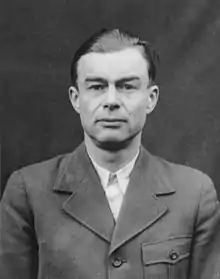 |
Director of the Department for Aviation Medicine at the German Experimental Institute for Aviation (Deutsche Versuchsanstalt für Luftfahrt) and First Lieutenant in the Medical Service of the Air Force; still researching and publishing in the field of aviation as late as 1989[4] | I | I | I | Acquitted; died 1989 | |
| Hans-Wolfgang Romberg |  |
Doctor on the Staff of the Department for Aviation Medicine at the German Experimental Institute for Aviation | I | I | I | Acquitted; died 1981 | |
| Georg August Weltz |  |
Oberfeldarzt in the Luftwaffe (Lieutenant Colonel, Medical Service, of the Air Force); and Chief of the Institute for Aviation Medicine in Munich | I | I | I | Acquitted; died 1963 | |
| Viktor Brack |  |
Oberführer (Senior Colonel) in the SS and Sturmbannführer (Major) in the Waffen SS; and Chief Administrative Officer in the Chancellery of the Führer of the NSDAP (Oberdienstleiter, Kanzlei des Führers der NSDAP) | I | G | G | G | Death by hanging, executed 2 June 1948 |
| Hermann Becker-Freyseng |  |
Stabsarzt in the Luftwaffe (Captain, Medical Service of the Air Force); and Chief of the Department for Aviation Medicine of the Chief of the Medical Service of the Luftwaffe | I | G | G | 20 years; commuted to 10 years; released 1952; died 1961 | |
| Konrad Schäfer | 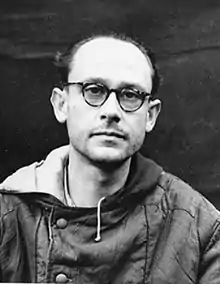 |
Doctor on the Staff of the Institute for Aviation Medicine in Berlin | I | I | I | Acquitted; died after 1951 | |
| Waldemar Hoven | 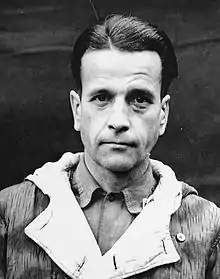 |
Hauptsturmführer (Captain) in the Waffen SS; and Chief Doctor of the Buchenwald concentration camp | I | G | G | G | Death by hanging, executed 2 June 1948 |
| Wilhelm Beiglböck | 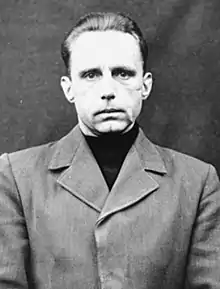 |
Consulting Physician to the Luftwaffe | I | G | G | 15 years; commuted to 10 years; released 15 December 1951; died 1963 | |
| Adolf Pokorny | 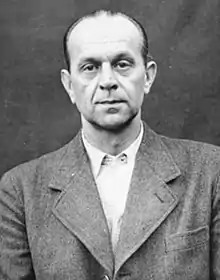 |
Physician, Specialist in Skin and Venereal Diseases | I | I | I | Acquitted | |
| Herta Oberheuser | 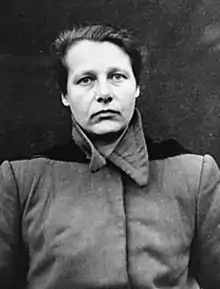 |
Physician at the Ravensbrück concentration camp; and Assistant Physician to the defendant Gebhardt at the hospital at Hohenlychen | I | G | G | 20 years; commuted to 10 years; released 1952; died 1978 | |
| Fritz Fischer |  |
Sturmbannführer (Major) in the Waffen SS; and Assistant Physician to the defendant Gebhardt at the hospital at Hohenlychen | I | G | G | G | Life imprisonment; commuted to 15 years; released March 1954; died 2003 |
All of the criminals sentenced to death were hanged on 2 June 1948 at Landsberg Prison.
For some, the difference between receiving a prison term and the death sentence was membership in the SS, "an organization declared criminal by the judgement of the International Military Tribunal". However, some SS medical personnel received prison sentences. The degree of personal involvement and/or presiding over groups involved was a factor in others.
See also

References
- "The Doctors Trial: The Medical Case of the Subsequent Nuremberg Proceedings". Holocaust Encyclopedia. United States Holocaust Memorial Museum, Washington, D.C.
- "The Doctors Trial: The Medical Case of the Subsequent Nuremberg Proceedings". encyclopedia.ushmm.org. Retrieved 2023-10-10.
- "The Doctors Trial". United States Holocaust Memorial Museum. Archived from the original on 2007-10-11. Retrieved 2007-10-11. – Excerpts from the official trial record, opening and closing statements, and eyewitness testimony.
- Ruff, Siegfried, et al. Sicherheit und Rettung in der Luftfahrt. Koblenz : Bernard & Graefe, c1989.
Further reading
- Hanauske-Abel, H. (1996). "Not a slippery slope or sudden subversion: German medicine and National Socialism in 1933". British Medical Journal. 313 (7070): 1453–1463. doi:10.1136/bmj.313.7070.1453. ISSN 0959-8138. PMC 2352969. PMID 8973235.(subscription required)
- Heller, Kevin Jon (2011). The Nuremberg Military Tribunals and the Origins of International Criminal Law. Oxford University Press. ISBN 978-0-19-955431-7.
- Lifton-Robert, Robert J. (2000) [1st. Pub. 1986 London:Macmillan]. The Nazi Doctors: Medical Killing and the Psychology of Genocide. Basic Books. ISBN 978-0-465-04905-9.
- Pellegrino, E. (15 August 1997). "The Nazi Doctors and Nuremberg: Some Moral Lessons Revisited". Annals of Internal Medicine. 127 (4): 307–308. CiteSeerX 10.1.1.694.9894. doi:10.7326/0003-4819-127-4-199708150-00010. PMID 9265432. S2CID 30547329.(subscription required)
- Seidelman, W. (1996). "Nuremberg lamentation: for the forgotten victims of medical science". British Medical Journal. 313 (7070): 1463–1467. doi:10.1136/bmj.313.7070.1463. ISSN 0959-8138. PMC 2352986. PMID 8973236.(subscription required)
- Spitz, Vivien (2005). Doctors from Hell. Sentient Publications. ISBN 978-1-59181-032-2.
- Weindling, P.J. (2005). Nazi Medicine and the Nuremberg Trials: From Medical War Crimes to Informed Consent. Palgrave Macmillan. ISBN 978-1-4039-3911-1.
External links
![]() Media related to Doctors' Trial at Wikimedia Commons
Media related to Doctors' Trial at Wikimedia Commons
- "Transcripts". The Nuremberg Trials Project. Harvard Law School Library. Archived from the original on 2011-04-15. – Partial transcript from the trial
- Cohen, Baruch C. "The Ethics Of Using Medical Data From Nazi Experiments". Jewish Law.
- Biddiss, M (June 1997). "Disease and dictatorship: the case of Hitler's Reich" (pdf). Journal of the Royal Society of Medicine. 90 (6): 342–346. doi:10.1177/014107689709000616. PMC 1296317. PMID 9227388.